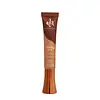What's inside
What's inside
 Key Ingredients
Key Ingredients

 Benefits
Benefits

 Concerns
Concerns

 Ingredients Side-by-side
Ingredients Side-by-side

Water
Skin ConditioningDimethicone
EmollientCyclopentasiloxane
EmollientIsododecane
EmollientMethylpropanediol
SolventGlycerin
HumectantPolysilicone-11
Glycereth-26
HumectantPentaerythrityl Tetraethylhexanoate
EmollientAmmonium Acryloyldimethyltaurate/Vp Copolymer
1,2-Hexanediol
Skin ConditioningHydroxyacetophenone
AntioxidantCaprylyl Methicone
Skin ConditioningPolysorbate 80
EmulsifyingPEG-11 Methyl Ether Dimethicone
EmulsifyingDipotassium Glycyrrhizate
HumectantDisodium EDTA
Tromethamine
BufferingCarbomer
Emulsion StabilisingMenthyl Lactate
MaskingXylitylglucoside
HumectantButylene Glycol
HumectantAnhydroxylitol
HumectantXylitol
HumectantSaccharide Isomerate
HumectantScutellaria Baicalensis Root Extract
AstringentGlycyrrhiza Inflata Root Extract
Skin ConditioningSophora Flavescens Root Extract
AntioxidantBiosaccharide Gum-1
HumectantPentylene Glycol
Skin ConditioningSodium Acetylated Hyaluronate
HumectantSodium Hyaluronate
HumectantSodium Citrate
BufferingCitric Acid
BufferingSodium Hyaluronate Crosspolymer
HumectantHydrolyzed Sodium Hyaluronate
Skin ConditioningEthylhexylglycerin
Skin ConditioningCI 17200
Cosmetic ColorantCI 19140
Cosmetic ColorantWater, Dimethicone, Cyclopentasiloxane, Isododecane, Methylpropanediol, Glycerin, Polysilicone-11, Glycereth-26, Pentaerythrityl Tetraethylhexanoate, Ammonium Acryloyldimethyltaurate/Vp Copolymer, 1,2-Hexanediol, Hydroxyacetophenone, Caprylyl Methicone, Polysorbate 80, PEG-11 Methyl Ether Dimethicone, Dipotassium Glycyrrhizate, Disodium EDTA, Tromethamine, Carbomer, Menthyl Lactate, Xylitylglucoside, Butylene Glycol, Anhydroxylitol, Xylitol, Saccharide Isomerate, Scutellaria Baicalensis Root Extract, Glycyrrhiza Inflata Root Extract, Sophora Flavescens Root Extract, Biosaccharide Gum-1, Pentylene Glycol, Sodium Acetylated Hyaluronate, Sodium Hyaluronate, Sodium Citrate, Citric Acid, Sodium Hyaluronate Crosspolymer, Hydrolyzed Sodium Hyaluronate, Ethylhexylglycerin, CI 17200, CI 19140
Water
Skin ConditioningGlycerin
HumectantPropylene Glycol
Humectant2,3-Butanediol
HumectantGlycereth-26
HumectantSqualane
EmollientNiacinamide
Smoothing1,2-Hexanediol
Skin ConditioningCetyl Ethylhexanoate
EmollientFicus Carica Fruit Extract
HumectantPunica Granatum Fruit Extract
AntioxidantHylocereus Undatus Fruit Extract
Skin ConditioningActinidia Chinensis Fruit Extract
EmollientFragaria Chiloensis Fruit Extract
Skin ConditioningZingiber Officinale Root Oil
MaskingCurcuma Longa Root Oil
PerfumingCurcumin
AntioxidantLinum Usitatissimum Seed Oil
PerfumingSimmondsia Chinensis Seed Oil
EmollientGlycyrrhiza Uralensis Root Extract
Skin ConditioningSodium Hyaluronate
Humectant3-O-Ethyl Ascorbic Acid
Skin ConditioningAmmonium Acryloyldimethyltaurate/Beheneth-25 Methacrylate Crosspolymer
Emulsion StabilisingButylene Glycol
HumectantEthylhexylglycerin
Skin ConditioningParfum
MaskingGlyceryl Stearate
EmollientGlyceryl Acrylate/Acrylic Acid Copolymer
HumectantHydroxyacetophenone
AntioxidantIsohexadecane
EmollientMica
Cosmetic ColorantPhenoxyethanol
PreservativePolysorbate 80
EmulsifyingPvm/Ma Copolymer
Emulsion StabilisingSodium Acrylate/Sodium Acryloyldimethyl Taurate Copolymer
Emulsion StabilisingSorbitan Oleate
EmulsifyingCI 77891
Cosmetic ColorantTocopheryl Acetate
AntioxidantXanthan Gum
EmulsifyingWater, Glycerin, Propylene Glycol, 2,3-Butanediol, Glycereth-26, Squalane, Niacinamide, 1,2-Hexanediol, Cetyl Ethylhexanoate, Ficus Carica Fruit Extract, Punica Granatum Fruit Extract, Hylocereus Undatus Fruit Extract, Actinidia Chinensis Fruit Extract, Fragaria Chiloensis Fruit Extract, Zingiber Officinale Root Oil, Curcuma Longa Root Oil, Curcumin, Linum Usitatissimum Seed Oil, Simmondsia Chinensis Seed Oil, Glycyrrhiza Uralensis Root Extract, Sodium Hyaluronate, 3-O-Ethyl Ascorbic Acid, Ammonium Acryloyldimethyltaurate/Beheneth-25 Methacrylate Crosspolymer, Butylene Glycol, Ethylhexylglycerin, Parfum, Glyceryl Stearate, Glyceryl Acrylate/Acrylic Acid Copolymer, Hydroxyacetophenone, Isohexadecane, Mica, Phenoxyethanol, Polysorbate 80, Pvm/Ma Copolymer, Sodium Acrylate/Sodium Acryloyldimethyl Taurate Copolymer, Sorbitan Oleate, CI 77891, Tocopheryl Acetate, Xanthan Gum
 Reviews
Reviews

Ingredients Explained
These ingredients are found in both products.
Ingredients higher up in an ingredient list are typically present in a larger amount.
1,2-Hexanediol is a synthetic liquid and another multi-functional powerhouse.
It is a:
- Humectant, drawing moisture into the skin
- Emollient, helping to soften skin
- Solvent, dispersing and stabilizing formulas
- Preservative booster, enhancing the antimicrobial activity of other preservatives
Butylene Glycol (or BG) is used within cosmetic products for a few different reasons:
Overall, Butylene Glycol is a safe and well-rounded ingredient that works well with other ingredients.
Though this ingredient works well with most skin types, some people with sensitive skin may experience a reaction such as allergic rashes, closed comedones, or itchiness.
Learn more about Butylene GlycolEthylhexylglycerin (we can't pronounce this either) is commonly used as a preservative and skin softener. It is derived from glyceryl.
You might see Ethylhexylglycerin often paired with other preservatives such as phenoxyethanol. Ethylhexylglycerin has been found to increase the effectiveness of these other preservatives.
Glycereth-26 is a synthetic ingredient and polyethylene glycol ether of Glycerin. Glycerin is already naturally found in your skin and helps keep your skin moisturized.
It is a humectant and helps add texture to products. It can make your product thicker.
As a humectant, it helps draw moisture from the air to your skin. This helps your skin stay hydrated.
Learn more about Glycereth-26Glycerin is already naturally found in your skin. It helps moisturize and protect your skin.
A study from 2016 found glycerin to be more effective as a humectant than AHAs and hyaluronic acid.
As a humectant, it helps the skin stay hydrated by pulling moisture to your skin. The low molecular weight of glycerin allows it to pull moisture into the deeper layers of your skin.
Hydrated skin improves your skin barrier; Your skin barrier helps protect against irritants and bacteria.
Glycerin has also been found to have antimicrobial and antiviral properties. Due to these properties, glycerin is often used in wound and burn treatments.
In cosmetics, glycerin is usually derived from plants such as soybean or palm. However, it can also be sourced from animals, such as tallow or animal fat.
This ingredient is organic, colorless, odorless, and non-toxic.
Glycerin is the name for this ingredient in American English. British English uses Glycerol/Glycerine.
Learn more about GlycerinHydroxyacetophenone is antioxidant with skin conditioning and soothing properties. It also boosts the efficiency of preservatives.
This ingredient is not irritating or sensitizing.
Polysorbate 80 is a surfactant and emulsifier. It is used to keep ingredients together, and prevent oils and waters from separating.
It is made from polyethoxylated sorbitan and oleic acid. This ingredient can be found in cosmetics, foods, and medicine. It is water-soluble.
Polysorbate 80 may not be fungal acne safe.
Learn more about Polysorbate 80Sodium Hyaluronate is hyaluronic acid's salt form. It is commonly derived from the sodium salt of hyaluronic acid.
Like hyaluronic acid, it is great at holding water and acts as a humectant. This makes it a great skin hydrating ingredient.
Sodium Hyaluronate is naturally occurring in our bodies and is mostly found in eye fluid and joints.
These are some other common types of Hyaluronic Acid:
Learn more about Sodium HyaluronateWater. It's the most common cosmetic ingredient of all. You'll usually see it at the top of ingredient lists, meaning that it makes up the largest part of the product.
So why is it so popular? Water most often acts as a solvent - this means that it helps dissolve other ingredients into the formulation.
You'll also recognize water as that liquid we all need to stay alive. If you see this, drink a glass of water. Stay hydrated!
Learn more about Water